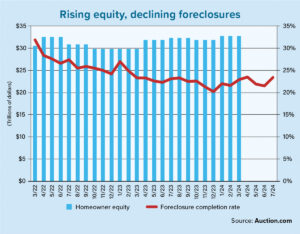In 2020, U.S. homeowners took advantage of historically low interest rates in numbers not seen in nearly two decades. About $772 billion in refinances were originated in the final three months of last year, which was more than double the quarterly average since 2000, according to data from Freddie Mac.
For the full year, data from the Mortgage Bankers Association (MBA) shows that the volume of refi loans topped $2.39 billion, not far from the peak of $2.53 billion recorded in 2003. Based on the number of owner-occupied households in the U.S., nearly one in 10 homeowners refinanced their mortgage last year.
The story was similarly bright for purchase volume as mortgage originators closed some $1.43 billion in business, MBA reported. This figure marked a 15-year high, a remarkable achievement considering the uncertainty that existed for mortgage companies of all shapes and sizes after the COVID-19 pandemic hit stateside.
The mortgage professionals who voluntarily submitted their production data for Scotsman Guide’s 2021 Top Originators rankings account for much of this purchase and refi business. Each of the 100 originators listed in this year’s Top Purchase Volume rankings closed more than $134 million in loans. The cutoff point for the 100th and final spot on the Top Refinance Volume list was even higher at more than $216 million.
For a second straight year, Shant Banosian of Guaranteed Rate earned the No. 1 position on the Top Purchase Volume list. During the 2020 production year, Banosian did $732.7 million in purchase loans, a 37% increase from the prior year. He was followed by Timothy Potempa of Fairway Independent Mortgage Corp., whose volume of $403.6 million soared by 190%, lifting him 31 spots higher compared to his spot in the 2020 rankings.
The remainder of the top five in purchase volume stayed the same as last year. Mark Howard Cohen of Cohen Financial Group Inc. placed third at $396.7 million. Ben Cohen of Guaranteed Rate finished fourth at $390.1 million and Andrew Marquis of Guaranteed Rate was fifth at $363.9 million.
Thuan Nguyen of Loan Factory Inc., who was the No. 1 Top Dollar Volume originator this year based on combined purchase and refi volume, is the repeat champion for Top Refinance Volume. In the 2020 production year, Nguyen did 96% of his business in the refi channel, closing $1.93 billion in loan volume. This was a 355% jump compared to the prior year.
The top of the refinance leaderboard was much more volatile than its purchase loan counterpart compared to the 2019 production year. Although Banosian finished No. 2 in refi volume for a second straight year — he closed $968.3 million in volume — the other three names in the top five are new. Third place went to Indy Johar of Draper and Kramer Mortgage Corp. ($888.1 million), and he was followed by Mike Roberts of City Creek Mortgage ($884.6 million) and Michael McClare of Residential First Mortgage ($778.1 million).
The effect of sub-3% interest rates for much of 2020 is evident when looking at the number of refi loans that were originated. In last year’s rankings, only Roberts and Nguyen did at least 1,000 loans. This year, 34 originators did that many. (NP)
Purchase loans poised to be a dominant force
 In June 2021, the Mortgage Bankers Association (MBA) projected that purchase loan origination volume would exceed $1.65 trillion this year. This prediction was up by 5.2% since the start of the year. As of this past June, the MBA also estimated purchase loan volumes would continue to rise over the next two years, reaching a new record high of $1.78 trillion in 2023.
In June 2021, the Mortgage Bankers Association (MBA) projected that purchase loan origination volume would exceed $1.65 trillion this year. This prediction was up by 5.2% since the start of the year. As of this past June, the MBA also estimated purchase loan volumes would continue to rise over the next two years, reaching a new record high of $1.78 trillion in 2023.
Originators will need to pivot to purchase loans if they haven’t already as the trade group projected the refinance share of all mortgages would drop to 50% by the end of this year. This coincides with moderate rises in interest rates, which are anticipated to average 3.4% in fourth-quarter 2021 and 3.8% in fourth-quarter 2022, according to Freddie Mac.
Sales of new and existing homes — which topped 7 million in three straight quarters starting in Q3 2020 — are expected to level off, according to a Fannie Mae forecast from this past June. The agency estimated that sales would increase by 4.2% this year and decrease by 3.1% next year. Growth in median home prices, which reached an annualized rate of 12.7% in Q1 2021 for all properties backed by loans through the Federal Housing Finance Agency, was expected to cool to 8% by the end of this year and plummet to 2.9% by the end of 2022. (NP)
Odds of a foreclosure wave are falling
 The number of U.S. homeowners in forbearance plans fell to 2.06 million in mid-June 2021, continuing a slow but steady decline, according to mortgage data provider Black Knight. This figure represented 3.9% of all U.S. homeowners.
The number of U.S. homeowners in forbearance plans fell to 2.06 million in mid-June 2021, continuing a slow but steady decline, according to mortgage data provider Black Knight. This figure represented 3.9% of all U.S. homeowners.
The U.S. reached a peak of 4.76 million homeowners in forbearance in May 2020. Forbearance was permitted on all federally backed mortgages after the onset of the COVID-19 pandemic. Industry observers were closely watching these numbers as exit volumes were expected to ramp up through the remainder of this summer.
CoreLogic reported that the nation’s overall mortgage delinquency rate was 4.9% this past March, the most recent numbers available. This rate is comprised of homeowners with payments at least 30 days past due, including those in foreclosure. The rate of serious delinquencies, defined as loans that are at least 90 days overdue, was 3.5% in March, three times higher than one year earlier but down from a high of 4.3% in August 2020.
Rising home prices and a subsequent increase in equity were lessening the chances of a foreclosure wave, CoreLogic reported. The data analytics company also cited rising employment numbers as a reason for the 0.8 percentage-point decline in delinquencies from February to March of this year, the largest monthly decrease since the start of the pandemic. (JD)
Halcyon days ending for refinance channel
 A surprising statistic jumps off the page in this year’s Scotsman Guide rankings. Eight of the top 25 originators on the 2021 Top Refinance Volume list generated all of their business without doing a single purchase loan. It speaks to the historical strength of last year’s refinance market. The 100 originators who are ranked this year did nearly $37 billion in aggregate volume, roughly the same value as the gross domestic product of countries like Tunisia, Paraguay, Libya and Bolivia.
A surprising statistic jumps off the page in this year’s Scotsman Guide rankings. Eight of the top 25 originators on the 2021 Top Refinance Volume list generated all of their business without doing a single purchase loan. It speaks to the historical strength of last year’s refinance market. The 100 originators who are ranked this year did nearly $37 billion in aggregate volume, roughly the same value as the gross domestic product of countries like Tunisia, Paraguay, Libya and Bolivia.
This golden age appears to be ending, however. In June 2021, the Mortgage Bankers Association (MBA) forecast that refi volumes would shrink from $2.4 trillion last year to $1.8 trillion in 2021. The next two years are likely to be even more bleak, MBA predicted, with the anticipated refi volume of $603 billion in 2023 representing a 75% pullback over a three-year period.
The good news? With home prices continuing to rise and property owners gaining larger amounts of tappable equity, cash-out refinances are expected to gain more traction in the latter half of 2021, according to a TransUnion report. Freddie Mac reported that the equity being cashed out by borrowers has steadily risen since bottoming out in 2014. In fourth-quarter 2020, cash-out volume reached $48.4 billion and more than one in three refis were of the cash-out variety. (NP)
Housing starts trend up despite headwinds
 Housing starts in the U.S. have been on an upward path for more than a decade, but rising prices for building materials are a cause for concern. The U.S. was on pace for 1.57 million housing starts in 2021, according to federal data released this past May. Single-family housing was on pace for nearly 1.1 million starts at this time, up 4.2% from the prior month.
Housing starts in the U.S. have been on an upward path for more than a decade, but rising prices for building materials are a cause for concern. The U.S. was on pace for 1.57 million housing starts in 2021, according to federal data released this past May. Single-family housing was on pace for nearly 1.1 million starts at this time, up 4.2% from the prior month.
Viewed over time, housing starts haven’t reached pre-Great Recession highs, but they have been increasing steadily since 2010. For instance, the U.S. had 1.17 million housing starts in 2016, according to the National Association of Home Builders (NAHB). More than half of the new housing starts through the first five months of this year occurred in the South, according to NAHB.
Homebuilder confidence in June dipped to a 10-month low, according a monthly sentiment survey from NAHB. The trade organization reported that concerns about lumber and other building-material costs, as well as delays in obtaining materials, were the main worries. Prices for building materials used in construction were up 16.5% year over year in May, NAHB reported. (JD)
Contributors: Jim Davis (JD), Neil Pierson (NP)
Verification: Krista Lowry, Brian Warr





